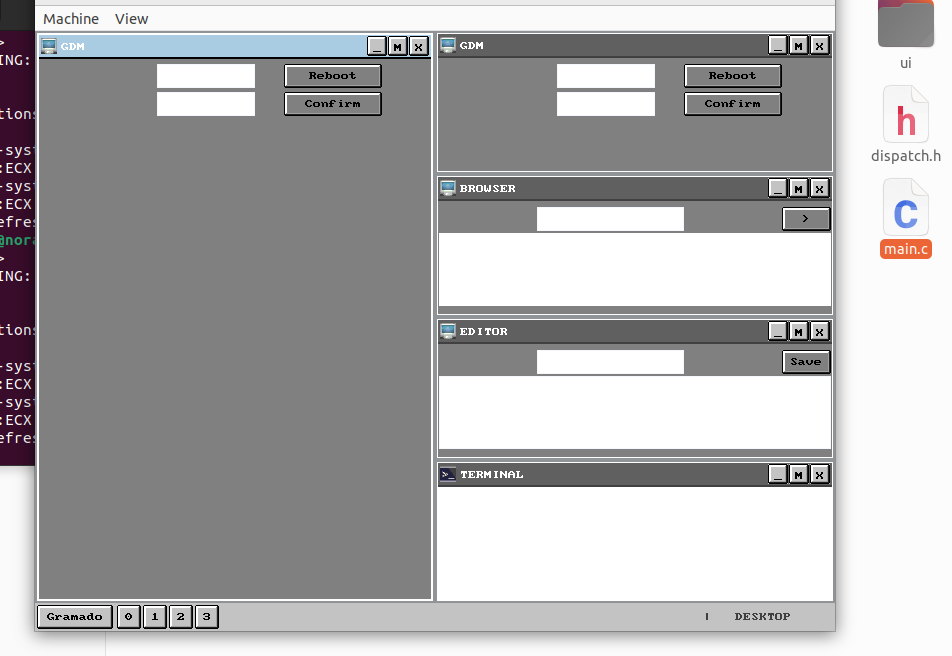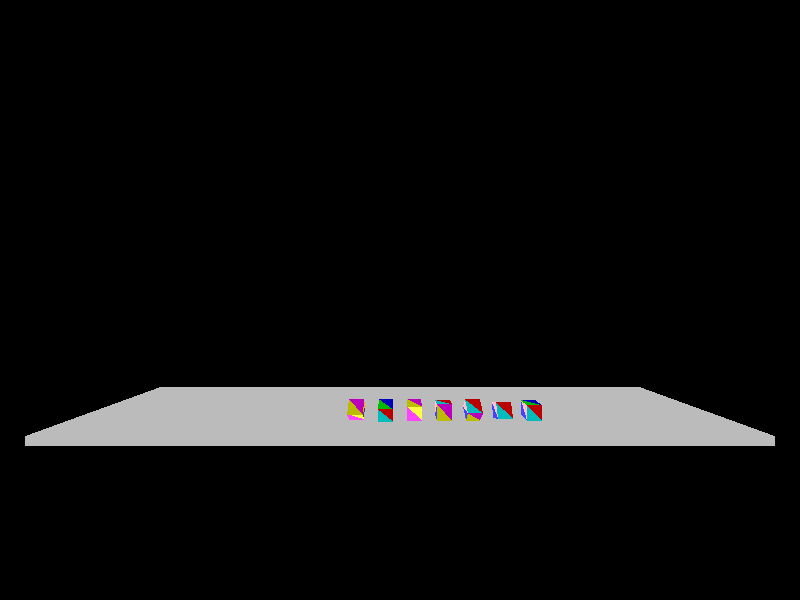gramadoOS
Building an operating system is a good way to understand how systems work and
the software stack needed to run your favorite application. But remember It's not
the best way to make money easily. So if you want to earn money easily,
go to the high demand area, which is probably the top layer of the stack,
which It is the place where web applications are made,
it includes front-end and back-end layers.
GramadoOS is a graphical operating system for x86_64 computers.
Gramado is a hobby operating system, not a commercial operating system, because it is a small system and has only some few features, not all the features needed by a commercial operating system.
- hw - cpu: Intel and AMD. 64bit only.
- hw - mm: Paging. Chunck of 2MB, using 4KB pages.
- hw - blk device: IDE PATA.
- hw - char device: ps/2 keyboard.
- hw - char device: ps/2 mouse works fine only on qemu.
- hw - char device: Serial port. (COM). Used for debug.
- hw - network device: e1000 Intel NIC. Works on Oracle virtual box.
- sw - Processes: Process structure and Thread structure.
- sw - Scheduler: Round robin. (Threads only).
- sw - Syscalls using software interrups. (Traps).
- sw - IPC: sockets.
- sw - IPC: System messages using a queue in the thread structure.
- sw - tty: It has 4 ring 0 kernel virtual consoles in fullscreen raw mode.
- sw - tty: General use ttys and ptys for ring3 virtual terminals.
- sw - fs: FAT16 file system for boot partition. No system partition yet.
- sw - posix libc: Ring0 implementation of libc functions called by the ring3 libraries.
- sw - network: Small support for sockets.
- sw - network: Small ring0 implementation of protocol stack. (ETHERNET, ARP, IP, UDP, TCP and DHCP).
- sw - display: Bootloader display device. VESA.
- sw - user: Very small implementation of user structure.
- sw - APIs:
- sw - One loadable ring0 module, using static address.
- Display Server.
- Unix-like commands running in the virtual console.
- Some few clients connected to the display server via unix-sockets.
- Ring3 processes can access the i/o ports via syscall. (For ring3 drivers only).
- The network server.
You can find the source code on Github in the internet, where you can clone the repository, contribute to the project or download the code. The address is https://github.com/gramado/kernel. We ned to import some dependencies to get the posix commands, the display server and the client-side GUI applications.
The next few lines has a brief description of the subdirectories:
... #todo
The main developer is Fred Nora, a brazilian developer. Fred Nora is the creator and main maintainer of the project. Contributions are welcome.
$ make
$ ./run$ make clean-allFor now the system has been compiled on Ubuntu operating system, LTS releases.
Host machine: Ubuntu 20.04.5 LTS
Linux 5.4.0-146-generic x86_64
gcc (Ubuntu) 9.4.0
GNU ld (GNU Binutils for Ubuntu) 2.34
NASM version 2.14.02
Host machine: Ubuntu 22.04.2 LTS
Linux 5.15.0-78-generic x86_64
gcc (Ubuntu) 11.4.0
GNU ld (GNU Binutils for Ubuntu) 2.38
NASM version 2.15.05
Host machine: Ubuntu 22.04.2 LTS
Linux 5.15.0-83-generic x86_64
gcc (Ubuntu) 11.4.0
GNU ld (GNU Binutils for Ubuntu) 2.38
NASM version 2.15.05
Host machine: Ubuntu 22.04.2 LTS
Linux 5.15.0-84-generic x86_64
gcc (Ubuntu) 11.4.0
GNU ld (GNU Binutils for Ubuntu) 2.38
NASM version 2.15.05
Host machine: Ubuntu 22.04.2 LTS
Linux 5.15.0-87-generic x86_64
gcc (Ubuntu) 11.4.0
GNU ld (GNU Binutils for Ubuntu) 2.38
NASM version 2.15.05
Host machine: Ubuntu 22.04.2 LTS
Linux 5.15.0-89-generic x86_64
gcc (Ubuntu) 11.4.0
GNU ld (GNU Binutils for Ubuntu) 2.38
NASM version 2.15.05
Yes, you can test the system on a virtual machine. The system has been tested by Fred Nora on qemu, qemu with kvm and virtualbox. Now, Fred Nora is testing the system only on qemu and virtualbox.
Yes, we can test the system in the real machines. This way we can improve the system. The older versions of the system were tested for a long period of time on a real machine. That machine was a Gigabyte machine with an Intel Core 2 Duo processor and a VIA chipset.
Yes, we need some feedback. Please make some comments on Github or send messages to Fred Nora.
- Fred Nora - Fred Nora's Twitter account
- Fred Nora - Fred Nora's Facebook account
- Fred Nora - Fred Nora's Facebook account
- Fred Nora 2 - Fred Nora's Facebook account
See the Gramado OS build instructions
You're reaching the boring area of this document!
The project has a folder for documentation and design notes. The folder is docs/.
See the docs.
The project is looking for some people to create a better documentation, for free, as a contribuition to the open source community. To create this new documentation we can use the documentation in docs/ and the design notes found all over the project.
Gramado is a Free and Open Source operating system. The source code uses the BSD license.
* Transfiguration
* "Close to the borders and beyond." (Grace).

